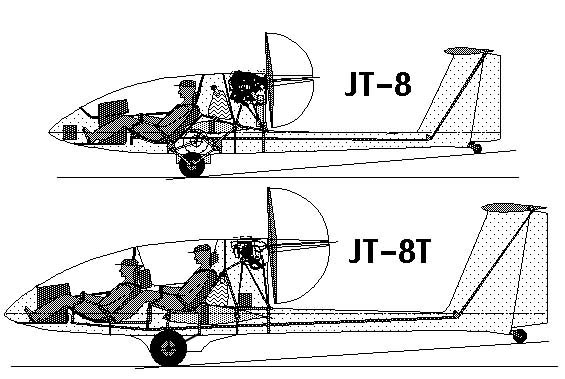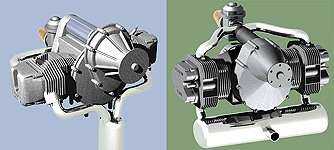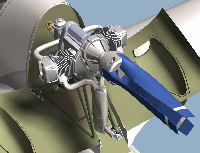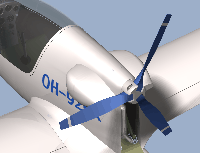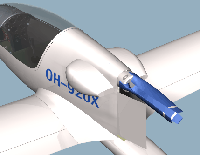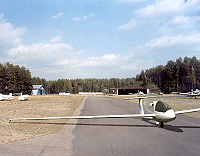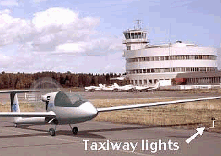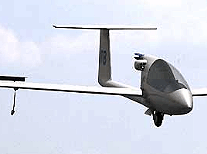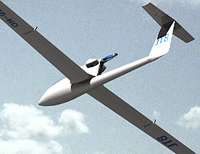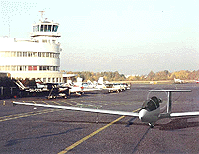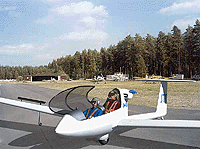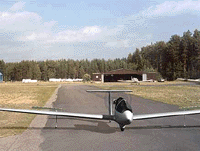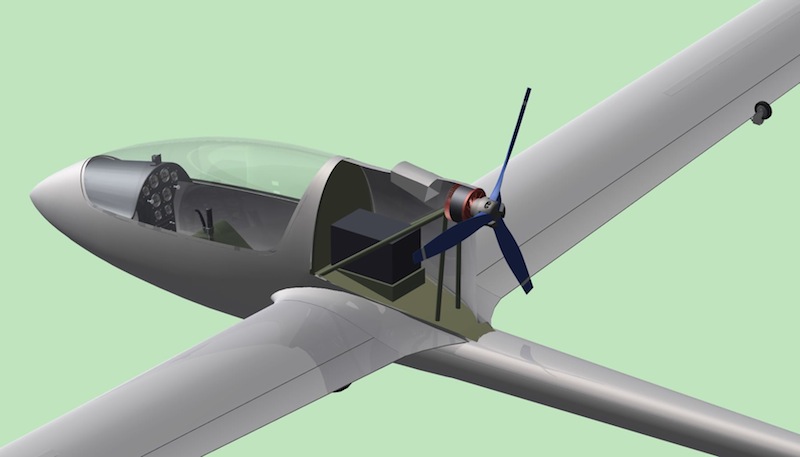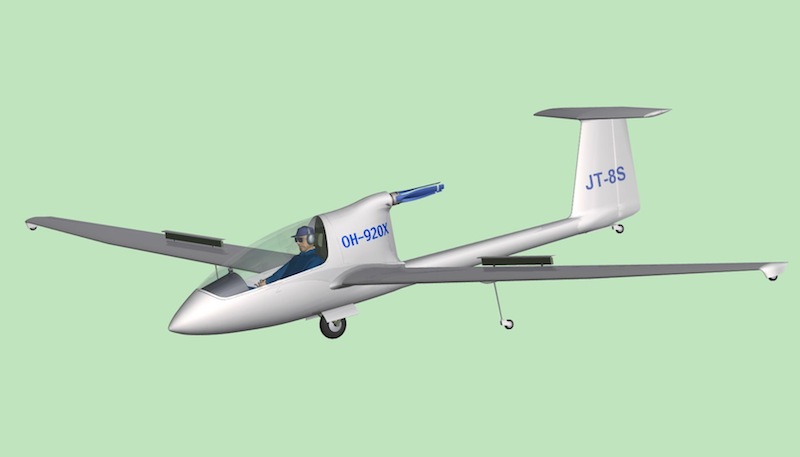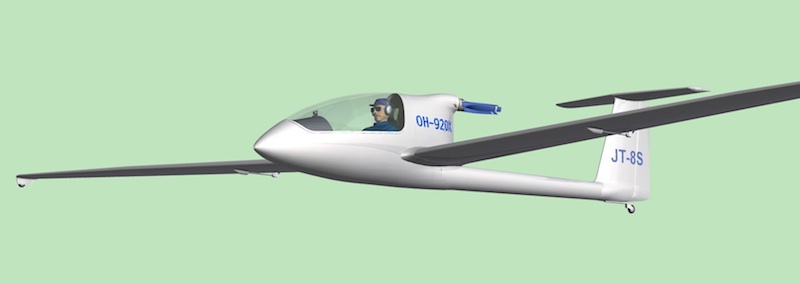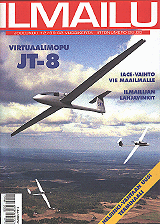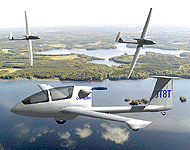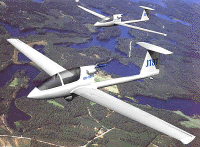|
|
||
|
||
A page for the motorglider + homebuilder enthusiast!
For the past 27 years I have flown a lot of hours with 2-cycle power, first a Solo Hirth in an ASK-14 and then a Rotax in my JT-6. While the 2-cycle powerplants are simple I would hardly say they are reliable. I have never dared to fly long distances with 2-cycle power, the maximum being about 100 km in situations like retrieval flights in deteriorating soaring weather. There are other reasons, too, like high fuel consumption and noisy cockpit. But I enjoy dreaming. For years I have been longing for reliable 4-cycle power in a new simple motorglider concept with no retractable engine or propeller belt drive but with good enough soaring performance to fly a 500 km triangle. Tinkering led me to a 3D modeling project, Virtual Motorglider JT-8 and JT-8T. It is a pod and boom concept with a pusher engine installation with an automatically folding 2- or 3-blade propeller. I modeled and rendered the virtual JT-8 using formZ RenderZone software.
Advantages of the JT-8 concept: JT-8 is not the first pod and boom motorglider concept with a pusher propeller but I feel there has not been one with a modern laminar airfoil and low drag fuselage with high refinement in engine installation details. L/D of 35 should be possible with this concept using a 15 m wing and from 38 to 40 using an 18 m wing. You may feel this a bit low compared to retractable engine motorgliders, but the JT-8 concept offers a number of other advantages: 1) Safety!! The airplane total drag with the JT-8 concept would be equally low in all the three important flight regimes: HKS is a geared
engine with gear ratios of 2.5 or 3. This results in a propeller rpm of
2400 which is low and requires a 3 bladed (may be 4-bladed) folding
propeller to absorb the power with a diameter of 1.2 m but offers the
extra benefit of very low propeller noise. The propeller tip speed
would be only about Mach 0.4. An alternative engine is available, the Hexadyne Aviation P60. Click the pictures to view the bigger size! The 3D-formZ models of HKS 700 and Hexadyne P60 as used in the JT-8 and JT-8T motorglider concepts. The carburettor in the models is only schematic. 5) Easy maintenance! With
hinged engine cowlings the engine would be easily accessible, see
picture below. In some of the newest retractable engine motorgliders
the engine is not so easily accessible. 6) From the soaring drag point of view
a pusher engine is a better arrangement than the one in RF-4,
Motorfalke, Grob 109 and Carat. The engine and prop (even feathered) on
the nose destroy the laminar air flow around the fuselage right from
the start. 7) Good visibility! In
the JT-8 the pilot is sitting forward of the wing. This is not so with
gliders having the engine on the nose. Compared even to the normal
gliders, the visibility would be better, too, because the seating is
more upright in JT-8 due to the bigger vertical dimensions necessitated
by the engine and propeller. There are three possible landing gear configurations:
The JT-8T (Twin, Tandem, Trainer) The author preparing the JT-8T for a flight with a virtual passenger on board. As a two place tandem version the JT-8 concept offers even more advantages than the single seater. The propeller could be made bigger (ca 1.5 m dia) with better efficiency. The rear seat for the instructor could have a higher position as in tandem fighters offering good forward visibility. The main landing gear could be fixed with only the outrigger wheels being retractable with the air brakes. Assuming a wing span of 16 m and a grossweight of 650 kg the rate of climb with a 60 hp engine would be better than 2.5 mps. With the 90 hp Rotax 912 the climb rate would be around 3.5 mps. Comparing the soaring performance with some existing trainers the JT-8T would not be as good as Grob 103 Twin Astir (L/D 37) but much better than Grob G 109 (L/D 25) offering a true tandem trainer feel and performance (L/D better than 30). The JT-8S (S= sähkö, electricity in Finnish) Electric propulsion has emerged to the sport aircraft field during
the past 10 years. The motorglider is a very favourable aircraft type
for electric propulsion since the engine power is needed for a fairly
short time only, to climb to the soaring altitude. Some electric
motorgliders already exist, the Lange Flugzeugbau Antares, the Alisport Silent and the Yuneec E430. With suitable electric motors and battery packs available today, I
also wanted to take a look at what a JT-8 might look like with Yuneec Power Systems
electric motor and battery pack installed. I therefore did some
remodeling of the JT-8 engine compartment and this is how it looks like
with a Power Drive 20 motor, a Power Block PB 20 and a 4,6 kWh Battery
Pack installed. The total weight of this system should not exceed 50 kg
with all the cables and necessary instruments included. A retractable
air scoop is necessary for engine cooling. I also increased the
propeller diameter for better efficiency.
|
||
|
How could it be made? The JT-8 concept could probably be worth small scale production but it would be a time-consuming and risky project. A faster way to realize a proof of the concept aircraft would be to modify an existing glider. But new gliders are expensive and too old ones are not up to date in aerodynamics. So how could one be made? One method is as follows: 1)
Buy a "kit." Every now and then insurance companies get damaged gliders
which are offered for sale to anyone willing to start a repair project.
A glider with a badly damaged fuselage but with wings and tail section
intact (or having only minor damage) would be an "economical kit" to
start with. You have to build a new fuselage anyway. The best choice
would be a 15 meter glider with 17 or 18 meter wing extensions. You
would not use the extensions but they guarantee that the wing spar is
strong enough to carry the extra load of the HKS engine and fuel.
Extensions indicate that wing roots have been designed for higher
bending loads. Once you have made the two fuselage mold halves, the work continues like any fiberglass/epoxy aircraft project made in female molds. It involves a lot of know how but the details of that process are quite another story. |
||
|
And Up We Go! Story of the JT-8 was published in December 1999 issue of the Finnish aviation magazine ILMAILU.
Download a beautiful Desktop picture(MacOS) or Screen Background (Windows) for 19-21 inch screens, jpg 130 kb Past and present motorgliders or motorglider projects resembling the JT-8 1) SZD-45 OGAR (1, 2, 3) Some of the Comments I have received Nice
job on the 3D rendering and concept design of your JT-8 Motorglider. I
started soaring last spring in the state of Minnesota in the US. I have
become enamored with the sport of Soaring and Motorgliders in
particular. I like the JT-8 design because of its realistic long rage
capability and retained L/D especially in the 18M configuration. The
safety factor of the quick engine restart is also a great feature. Who
knows, maybe someday in the future, when I am independently wealthy, I
can be the one to finance the building of the JT-8. Thanks for sharing your design ideas with the world, Blake S. Miller -------------------------------- You have an very interesting site and project in the JT-8. I am currently building a Windrose motorglider, that I hope I can finish soon. Best Jan Carlsson ------------------------------ Hyvä artikkeli ja sait varmaankin aikaan jonkinlaista kuhinaa Otaniemessä. Ennenkaikkea mallinnus on onnistunut oikein hyvin. Petri H ------------------------------ I just came across your web page and I am very impressed with the JT-8 and your graphics. I am building a motorglider that looks almost identical except it is a high wing. Gross weight 700lbs(I hope) 15 meters, 40 hp Rotax. Terry Wells Kauai, Hawaii ----------------------------- I would like to pursue the JT-8 concept. I am particularly interested the application of new alloys to the concept. I feel the aircraft could be made with the materials I have in mind. I am particularly sold on your engine choice. Do you have plans for sale? license? or some other arrangement. Darwin Nunley ----------------------------- I came across you pages while I was doing a search for the Grob 109. Bravo, you have done an outstanding job designing your JT-8 Motorglider. It is a beautiful airplane and I hope you will build it. It reminds me of the SZD-45 Ogar of which I am very fond. Good luck with your project, Tom Frazier ------------------------------ Hello from Australia!! Your concept for the JT8 is beautiful! I started building a Strojnik S2A about 5 years ago................a big job. I have fuselage tube, bulkheads etc built, main spar etc, so I am a bit far down the track to be changing plans. Unlike Strojnik's fuselage pod design, (timber, foam glass with flat wrap canopy) I designed a plug and hence mold for the fuselage. This fuselage was designed using Peter Garrison's Loftsman software. I have attached a jpg for your interest. It is very similar to your concept JT8. Keep up the good work Cheers Mark ------------------------------ Yes, Jukka, it seems that EXEL and JT-8 share many ideas, and especially the "pod and boom" formula, for the same reason (economy and security). That was also Alex Strojnik's choice, before us... You're also a great modeler with 3-D software. Your work is fantastic. If only we could have such skills in our team ! Christophe Bordeaux Alpaero |
||

